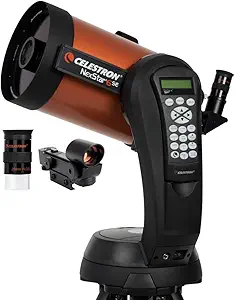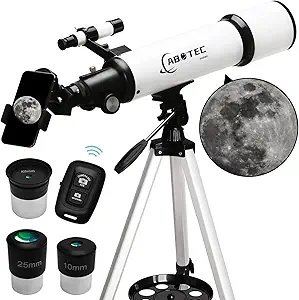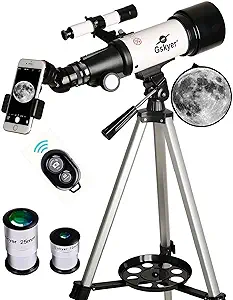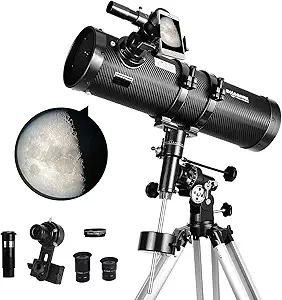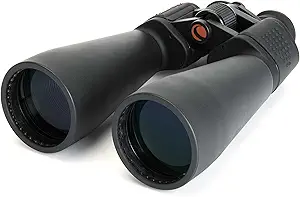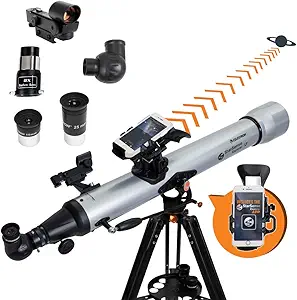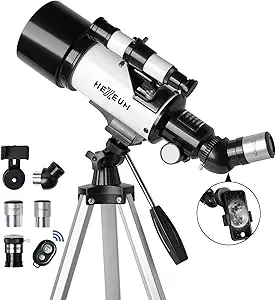The Ultimate Buying Guide for Telescopes for Adult Astronomy
Overview
If you're interested in exploring the night sky, a telescope is a must-have tool. However, with so many different types, features, and price points to consider, choosing the right one can be overwhelming. That's why we've put together this comprehensive buying guide to help you navigate the world of telescopes for adult astronomy.
Types
There are three main types of telescopes: refractors, reflectors, and catadioptrics. Each has its own strengths and weaknesses.
- Refractors: These telescopes use lenses to gather and focus light. They're typically easy to use and require little maintenance, but they can be expensive and have a limited field of view.
- Reflectors: These telescopes use mirrors to gather and focus light. They're great for observing faint objects and have a wider field of view, but they require more maintenance and can be bulky.
- Catadioptrics: These telescopes use a combination of lenses and mirrors to gather and focus light. They're compact and versatile, but they can be expensive and have a smaller field of view.
Key Considerations
When choosing a telescope, there are several key considerations to keep in mind:
- Aperture: This refers to the diameter of the telescope's main lens or mirror. The larger the aperture, the more light the telescope can gather, resulting in brighter and clearer images.
- Focal length: This refers to the distance between the telescope's main lens or mirror and the point where the image is focused. A longer focal length can result in higher magnification, but it can also make the telescope bulkier.
- Mount: The mount is what holds the telescope steady and allows you to adjust its position. There are two main types of mounts: alt-azimuth (up-down, left-right) and equatorial (diagonal). Equatorial mounts are better for tracking objects as they move across the sky.
- Tripod: The tripod is what the mount sits on. Look for a sturdy tripod that can support the weight of your telescope.
- Eyepiece: The eyepiece is what you look through to view the image. Different eyepieces can provide different levels of magnification and field of view.
Features
There are several features that can enhance your telescope experience:
- Go-to technology: Some telescopes come with computerized systems that can automatically locate and track objects in the sky.
- Astrophotography capabilities: If you're interested in taking pictures of the night sky, look for a telescope that's compatible with a camera.
- Collimation tools: Reflectors require regular collimation (alignment of the mirrors). Look for a telescope that comes with the necessary tools.
Prices
Telescopes can range in price from less than $100 to thousands of dollars. While it's tempting to go for the cheapest option, keep in mind that a higher-quality telescope will provide better images and last longer. Expect to pay at least a few hundred dollars for a decent telescope.
Tips
- Consider attending a star party or joining an astronomy club to try out different telescopes and get advice from experienced astronomers.
- Don't be swayed by high magnification claims. A telescope with a low-quality lens or mirror won't provide clear images no matter how high the magnification.
- Consider buying a telescope with a larger aperture than you think you'll need. You'll appreciate the extra light-gathering power when observing faint objects.
FAQs
Q: Can I use a telescope to look at planets?
A: Yes, telescopes are great for observing planets. Look for a telescope with a high focal length for the best views.
Q: Can I use a telescope in the city?
A: Yes, but light pollution can make it harder to see faint objects. Consider buying a filter to reduce the effects of light pollution.
Q: Can I use a telescope for daytime viewing?
A: Yes, but you'll need to use a special filter to protect your eyes.
Q: How do I clean my telescope?
A: Follow the manufacturer's instructions carefully. Use a soft cloth and gentle cleaning solution to avoid scratching the lens or mirror.
Conclusion
In conclusion, choosing the right telescope for adult astronomy can be a daunting task, but with the right information and guidance, you can find the perfect telescope to suit your needs. Keep in mind the key considerations, features, and tips outlined in this guide, and don't hesitate to reach out to experienced astronomers for advice. Happy stargazing!

